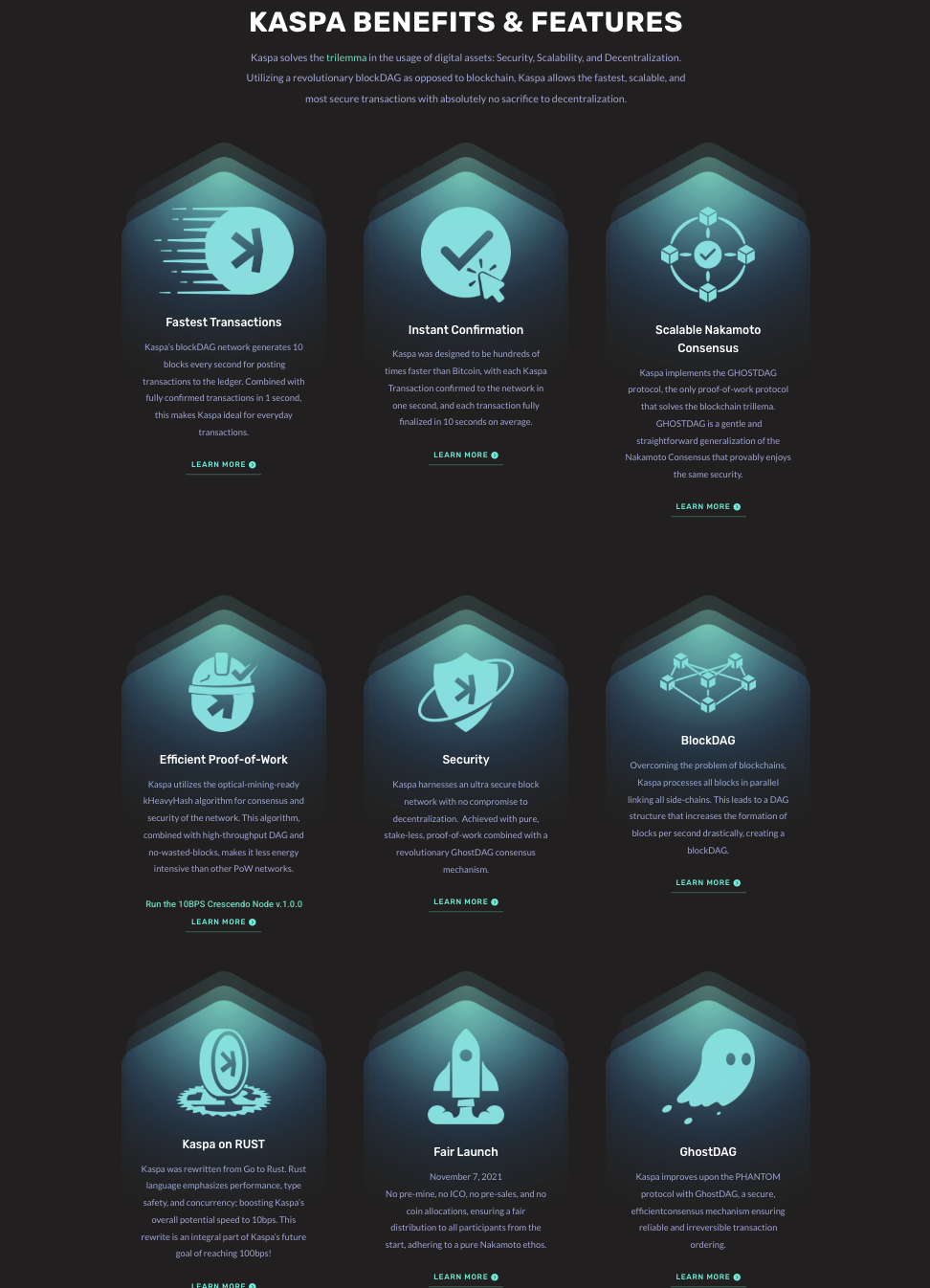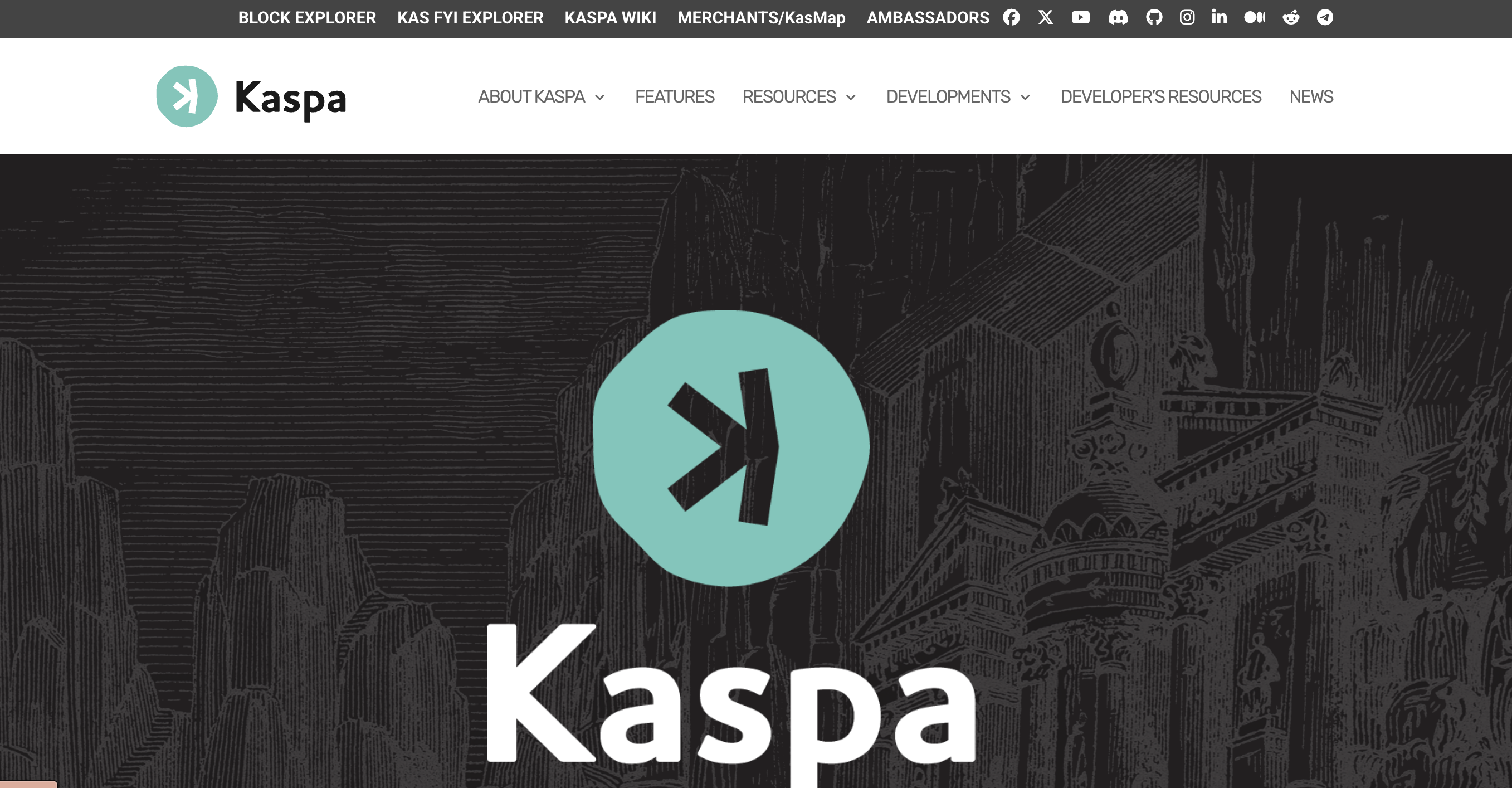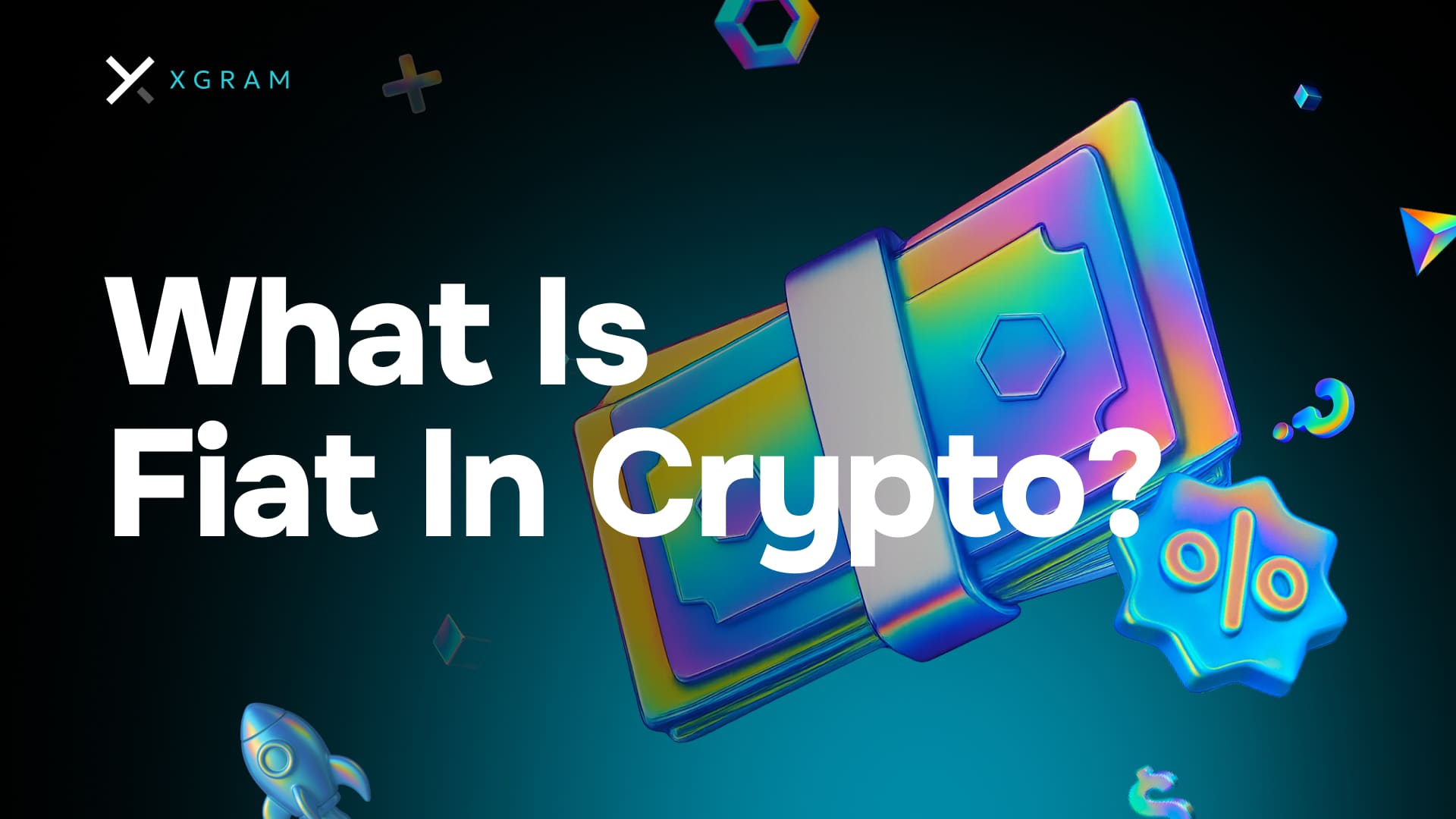TL;DR. Kaspa is a digital cryptocurrency project built on a Directed Acyclic Graph (DAG) approach (often called GHOSTDAG), aiming for high-speed and secure transactions. It positions itself as more scalable than older blockchains, which could make it appealing if you are searching for faster networks. For beginners, Kaspa offers a user-friendly experience, so you do not need deep technical skills to join. Still, it is essential to do your own research, because all crypto investments involve risk.
Explore the basics of Kaspa
Understanding the blockchain vs. DAG difference
To appreciate what makes Kaspa distinct, it helps to know how it differs from standard blockchain-based cryptocurrencies. Traditional blockchains, like Bitcoin, arrange data in a single chain of blocks. This process can sometimes slow down confirmation speeds when network usage spikes.
Kaspa, on the other hand, uses GHOSTDAG, an approach that processes multiple blocks in parallel, forming a Directed Acyclic Graph (DAG) structure. Instead of waiting for one block at a time, the DAG method weaves together blocks in near real-time. This design intends to:
- Provide faster transaction confirmations.
- Handle higher throughput so the network can potentially scale better.
- Reduce bottlenecks that often plague older networks when too many transactions occur at once.
Why beginners care about transaction speed
If you are just starting your crypto adventures, you might wonder if you really need that extra transaction speed. Generally, speed becomes a big deal when:
- The network gets crowded with many users sending or receiving crypto.
- Fees spike due to heavy network congestion.
- Time-sensitive applications, such as decentralized exchanges, rely on quick confirmations.
Kaspa’s GHOSTDAG structure aims to give you a smoother experience during peak usage times, minimizing the slowdown that can occur on single-chain blockchains. That potential speed advantage is a key selling point for network newcomers.
Kaspa’s origin and community
Kaspa is not as well-known as Bitcoin or Ethereum, so if you join its community, you will notice a close-knit group of passionate supporters. Like many emerging crypto projects, Kaspa draws enthusiasts who are excited about next-generation scaling solutions. Participation is typically open to everyone, which means you can follow public development chats, voice your ideas, and watch the project grow.
Discover Kaspa’s main features
GHOSTDAG at the core

The standout feature of Kaspa is GHOSTDAG, a DAG-based protocol that organizes blocks in parallel rather than in one linear chain. Using GHOSTDAG:
- Blocks do not need to confirm sequentially.
- The network can process multiple newly mined blocks concurrently.
- Consensus is reached through a different mechanism that merges the blocks into a common history, allowing fewer orphaned blocks.
It sounds technical, but from your perspective as a beginner, think of it this way: the network can handle more blocks at once, ideally resulting in quick transaction processing without the same risk of congestion found in older protocols.
Mining and security
Mining secures proof-of-work (PoW) cryptos by requiring computing power to solve mathematical puzzles. Although Kaspa uses a DAG instead of a single chain, the project still applies a PoW approach, which many see as a time-tested security layer.
- Kaspa miners compete to add blocks to the DAG, verifying and bundling up transactions.
- The GHOSTDAG algorithm then arranges these blocks quickly into a unified ledger.
Community-driven development
Kaspa’s code is open source, meaning anyone can review and contribute to its repository. If you want to see the project’s progress or even test-drive new features, you can often find the community on social media or developer platforms. Beginners might not dive into the code immediately, but being aware that the project is open and transparent can build trust in its long-term prospects.
Learn how to engage with Kaspa
Acquiring Kaspa
If you wish to purchase Kaspa, you will typically follow these steps:
- Sign up on a supported cryptocurrency exchange or use a peer-to-peer trading platform that lists KAS (the ticker symbol for Kaspa).
- Deposit fiat currency (e.g., USD) or another crypto (like Bitcoin) to fund your account.
- Exchange your deposited funds for Kaspa.
- Withdraw your newly bought KAS to your personal wallet for safekeeping, if desired.
Some international brokers and smaller exchanges carry KAS. However, availability might vary by region, so it is vital to check which platforms are accessible in your country.
Storing your coins
Keeping your Kaspa holdings in a secure wallet reduces your exposure to potential exchange hacks or service interruptions. Like other cryptocurrencies, Kaspa can be stored in:
- Software wallets. Downloadable applications for desktop or mobile, usually user-friendly for beginners.
- Hardware wallets. Physical devices that keep your keys offline, providing a higher security layer.
- Paper wallets. Printed copies of your private key, though these can be lost or damaged, so it is crucial to store them carefully.
When choosing a wallet, consider your comfort level with technology and how much control you want over private keys. Self-custody typically means you guard your own keys, which can give more control but also more responsibility.
A note on xgram (Russian)
Ниже приведены пять предложений на русском языке про xgram, который вы можете использовать, чтобы сделать кроссчейн обмены и обычные обмены, сэкономив на комиссиях. Вам не нужно подключать кошелек, что упрощает первый опыт. Платформа предлагает удобный интерфейс и несколько основных функций безопасности. При этом xgram старается поддерживать популярные сети, чтобы расширить выбор валюта-пары. Если вы хотите протестировать кроссчейн транзакции, xgram может стать полезной точкой входа в мир обменов.
Crosschain exchanges and transaction options
For many new investors, the idea of crosschain exchanges or bridging tokens across different networks can be confusing at first. However, the main benefit is flexibility. The ability to swap one crypto for another, even if those cryptos are on different chains, can open more possibilities for trading and diversifying your holdings.
- If Kaspa gets integrated into cross-network platforms, you might have more ways to acquire or trade KAS.
- Always watch out for fees and transaction times, as bridging between chains sometimes involves higher costs if the underlying network is busy.
Check Kaspa’s potential use cases
Payment and transfers
While some cryptocurrencies focus primarily on store-of-value, others, like Kaspa, aim to serve as a medium of exchange. The project’s DAG structure attempts to ensure faster transaction times, which can be attractive for small or frequent payments. If you are just starting out in crypto, keep in mind:
- Any new coin’s adoption for real-world payments often depends on merchant acceptance.
- Kaspa’s speed could be useful in theoretical payment solutions, but it still needs more adoption for it to become a day-to-day currency.
Future-proof scaling
Kaspa’s supporters believe that using DAG protocols can help future-proof the project. As crypto technology evolves, the idea is that a DAG-based network could adjust more effectively to rising network usage. If the network truly scales as promised, it might handle large transaction volumes better than older, linear blockchains.
Community and developer innovation
Community engagement is another potential advantage. Over time, you might see new dApps or creative projects building on or around Kaspa’s network. Such growth often depends on developer interest, real-world partnerships, and general enthusiasm about the technology. As a beginner, you can stay informed by exploring official forums or joining social channels where updates are posted.
Weigh possible pros and cons
Like any cryptocurrency, Kaspa brings both opportunities and challenges. Here is a snapshot:
| Aspect | Potential Pros | Potential Cons |
|---|---|---|
| Speed & Throughput | Fast transactions via DAG | Technology is still relatively new |
| Security | PoW model is well understood | Energy consumption can be high |
| Development | Open-source and community-driven | Adoption largely depends on investor interest |
| Scalability | GHOSTDAG aims to reduce congestion | Needs rigorous testing under peak usage |
From your perspective as a beginner, always do your own research, experiment only with funds you can afford to lose, and learn from reputable sources before going all-in.
Understand the broader crypto landscape
Comparing Kaspa and big names
If you have heard of Bitcoin or Ethereum, you know each has distinct goals and methods of operating. While Bitcoin is the original store-of-value concept, Ethereum fosters a broad smart-contract ecosystem. Kaspa, however, focuses on DAG-based efficiency. Comparing Kaspa to these giants might feel unfair since it is younger in adoption levels, but it is still useful to see how each solves different problems.
- Bitcoin is known for security and decentralization, but also for slower speed.
- Ethereum offers smart contracts but has faced its share of congestion issues (though upgrades are ongoing).
- Kaspa aims to deliver speed and scalable security in a simpler currency model, but it needs more real-world usage to prove itself fully.
Navigating altcoins as a beginner
There are thousands of altcoins (cryptocurrencies beyond Bitcoin), each with unique selling points. Some deliver faster transactions, others focus on privacy, and others attempt to power niche use cases. Kaspa is one in a sea of altcoins, so it is critical to ask yourself:
- Does this project solve a real problem?
- Is its approach innovative enough to stand out?
- How strong is the community and development support?
Kaspa’s use of DAG technology is noteworthy, but as with any altcoin, success is not guaranteed. Evaluate carefully and keep your eyes open for market signals, partnerships, and actual dApp usage.
Follow best practices for beginners
Start small and learn
When you are researching “what is Kaspa” or any other crypto, begin with small test transactions. Familiarize yourself with the exchange interface or the wallet you plan to use. By starting with modest amounts, you lessen risk as you learn the ropes.
Stay updated on project news
Crypto markets move fast. Keep an eye on Kaspa’s official social media channels, community forums, and reputable crypto news outlets. Regular updates can highlight:
- Ongoing technical improvements.
- Partnerships or exchange listings that affect Kaspa’s accessibility.
- Regulatory changes that might impact trading or holding certain cryptocurrencies.
Engage in community-driven resources
You do not have to become a developer to engage with the Kaspa community. Many forums welcome questions, and there are often channels designed specifically for beginners. You can post about your experiences, learn about upcoming network upgrades, and spot potential scam alerts.
Diversify your portfolio
Kaspa might pique your interest, but it is wise to explore various projects if you intend to invest more broadly in cryptocurrency. Diversification often buffers you against market volatility, ensuring that a downturn in one project does not sink your entire portfolio. While it is tempting to go “all in” on a coin that excites you, a balanced portfolio is usually a safer long-term strategy.
Work with caution and curiosity
Regulatory environment
As with many crypto assets, Kaspa may face shifting legal policies in different countries. Some regions have strict regulations on crypto trading or might ban certain digital currencies outright. Make sure you know your area’s regulations before purchasing or using Kaspa. Seek professional financial advice if you are unsure how these regulations may affect you.
Security considerations
Scammers often target newcomers in the crypto world. Staying safe includes:
- Using official wallets or well-reviewed alternatives, not random links shared by strangers online.
- Double-checking websites for phishing attacks.
- Avoiding suspicious private messages asking for personal info or “urgent” help.
By exercising caution and verifying your sources, you reduce the risks associated with being new to the crypto space.
Frequently asked questions
What makes Kaspa unique among cryptocurrencies?
Kaspa uses GHOSTDAG technology, allowing multiple blocks to be processed simultaneously rather than in a single chain. This can potentially speed up transactions and reduce congestion compared to older blockchain models.Is Kaspa safe for beginners?
Kaspa is generally considered beginner-friendly because of its straightforward focus on speed and transaction capacity. However, like any crypto project, it carries investment risk. Always learn the basics, secure your wallet, and never invest more than you can afford to lose.Can I mine Kaspa with regular hardware?
It depends on the current mining difficulty and your hardware’s capabilities. Some users do try mining with GPUs, but profitability varies. You should research updated guides on Kaspa mining, watch out for electricity costs, and confirm that your equipment can handle the requirements.How does Kaspa compare to older blockchains like Bitcoin or Litecoin?
Kaspa’s main difference lies in its use of a DAG approach (GHOSTDAG), designed for quicker, more scalable transactions. Bitcoin and Litecoin rely on single-chain block production, potentially making them slower under heavy loads. Kaspa aims to address that speed gap, but it lacks the same widespread adoption so far.Where can I learn more about Kaspa’s technology?
The official website, community forums, and social media pages are good starting points. You can often find technical documentation in the project’s open-source repositories, which cover whitepapers, code updates, and community-driven experiments.
Final thoughts
If you have just discovered Kaspa in your crypto journey, you are already part of a growing crowd seeking faster and more scalable digital currencies. Whether Kaspa’s DAG approach will become a major player remains to be seen. Still, its foundational concept of parallel block processing shows promise for newcomers who value transaction speed.
Keep a balanced approach. Research carefully, diversify when investing, and engage with the Kaspa community to deepen your knowledge. The world of crypto moves at lightning speed, and Kaspa’s success will rely on real-world usage, continuous innovation, and a supportive user base like you. By staying informed and cautious, you can explore “what is Kaspa” and make confident choices that align with your interests and financial goals.





